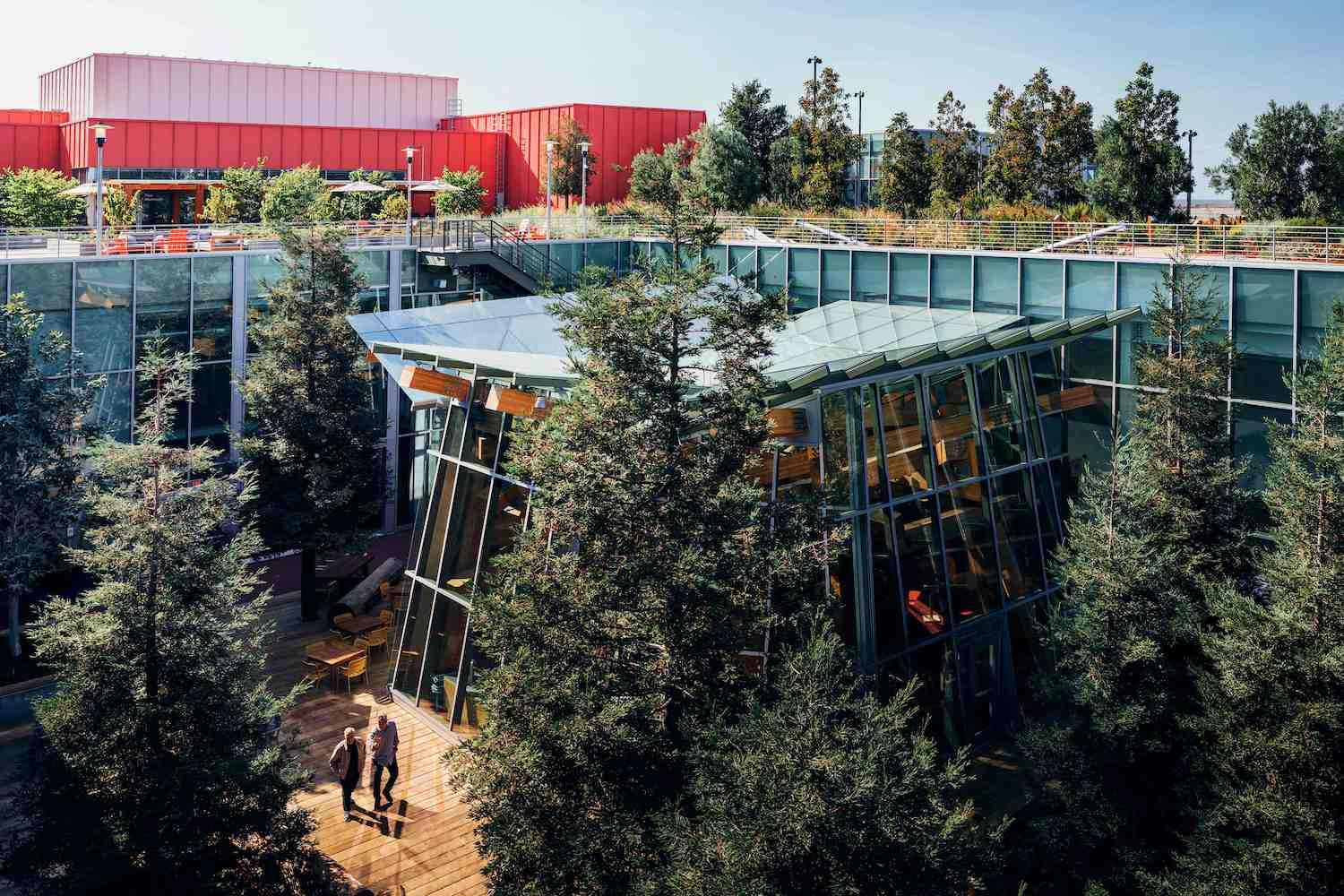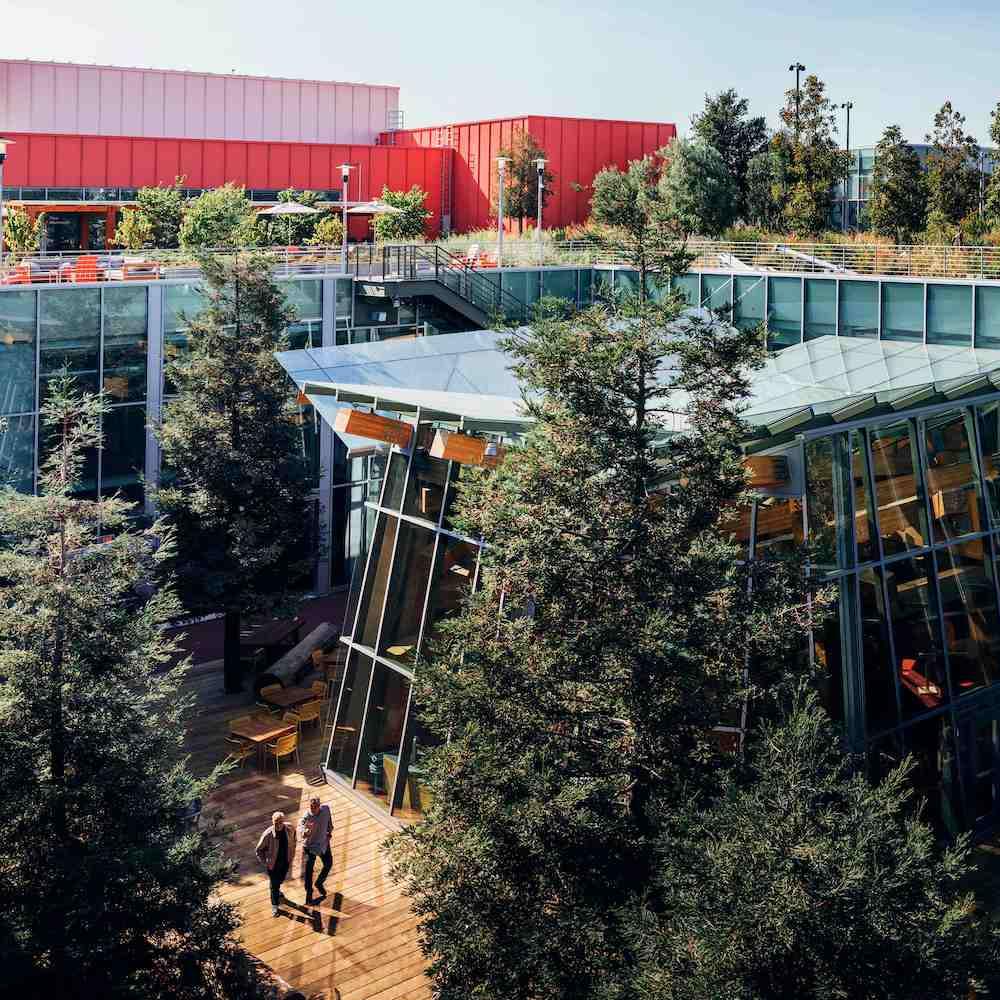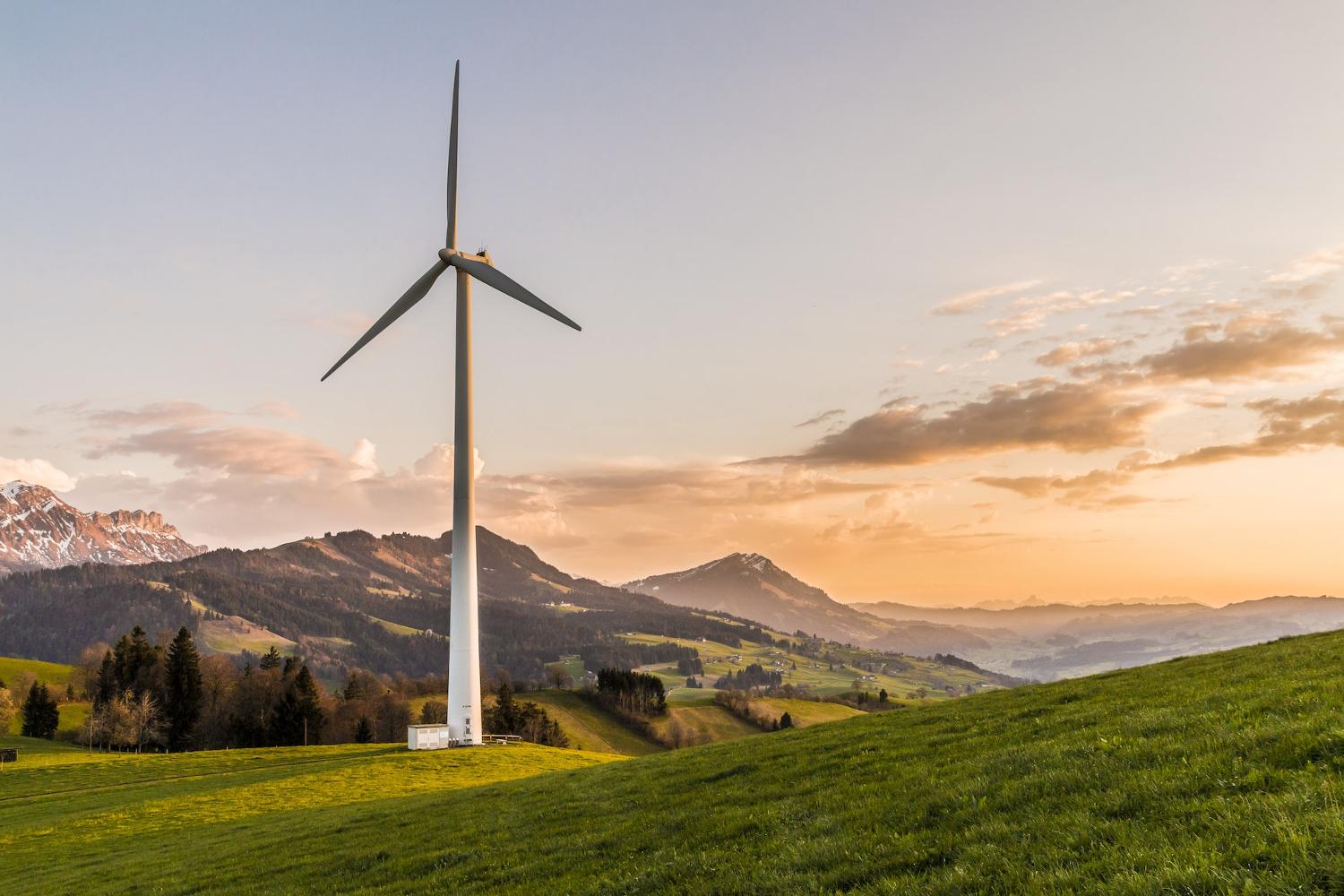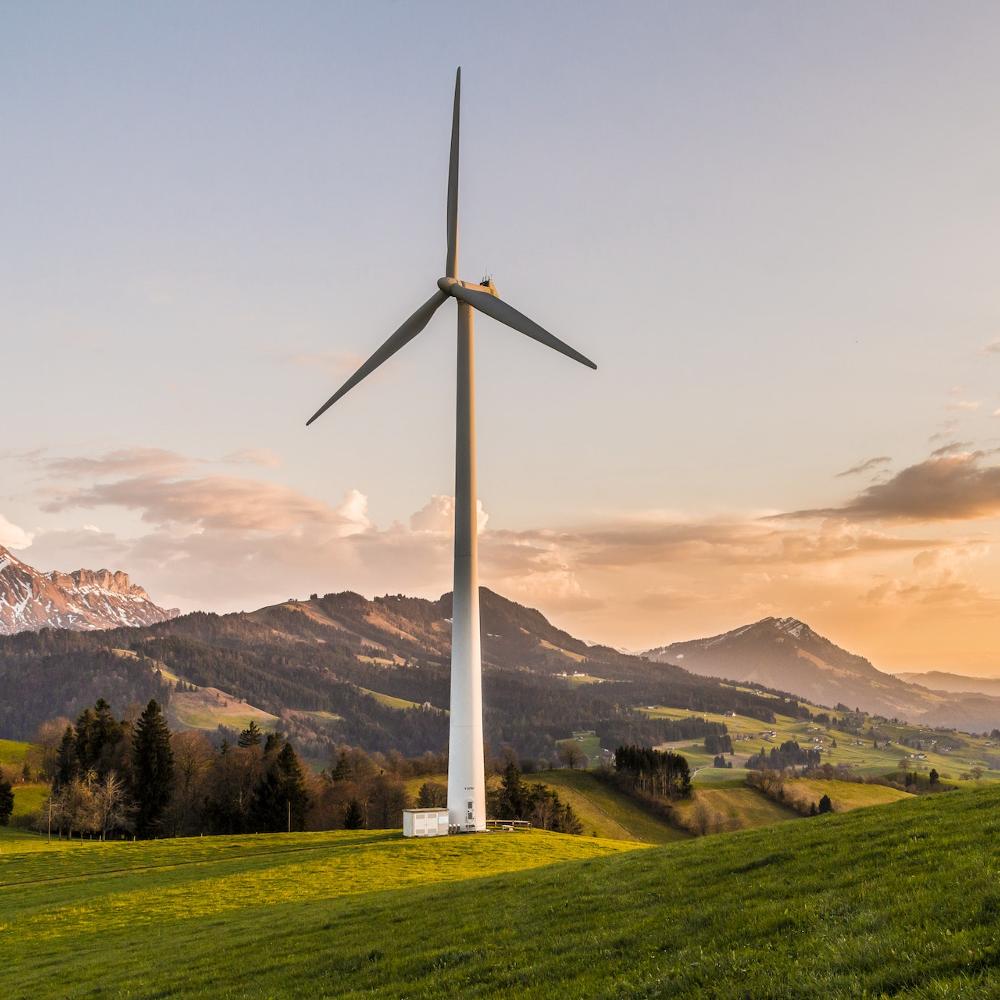About the Hydrogen Rainbow: How Hydrogen is Made Determines Its Impact
Natural gas (methane) fossil fuel infrastructure outside a building in California. Most hydrogen produced today actually comes from methane. (Credit: © 2023 Katharine Bierce)
Hydrogen is used in a variety of industries. According to the U.S. Energy Information Administration, nearly all of the hydrogen consumed in the United States is used by industry in oil refining, treating metals, making fertilizer and processing foods. It has the potential to decarbonize hard-to-electrify industries like steel-making and the manufacture of industrial chemicals like ammonia and methanol. It may also be useful for decarbonizing heavy industry, shipping, aviation and heavy-duty transport, according to the IEA.
But where does hydrogen come from? Let's take a closer look at how most hydrogen is currently produced and the challenges with these methods.
How is most hydrogen currently produced?
Nearly all hydrogen produced today is not green, which is to say, it’s not environmentally sustainable. At the end of 2021, almost 47 percent of global hydrogen production was made from methane, 27 percent from coal and 22 percent from oil (as a by-product), according to the International Renewable Energy Agency. Only around 4 percent came from splitting water apart with electricity, called electrolysis.
As a result, making hydrogen is responsible for around 830 million tons of carbon dioxide emissions per year, equivalent to the CO2 emissions of the U.K. and Indonesia combined. Since only about a third of electricity globally is produced from renewables, that means only about 1 percent of global hydrogen is green — as in, made with renewable energy.
This matters because if we want to meet the Paris agreement target of limiting global warming to 1.5 degrees Celsius, we need to stop using fossil fuels. Ending fossil fuel dependence also includes stopping the use of fossil fuels to make hydrogen — and investing more in technologies that are powered by renewables.
What is gray hydrogen?
Gray hydrogen is made from methane (CH4), a fossil fuel. The International Energy Agency has noted that 6 percent of global methane (natural gas) production goes to making hydrogen. When you burn methane with oxygen in the air, you produce carbon dioxide, a greenhouse gas, and water.
What is black or brown hydrogen?
This kind comes from coal, accounting for 2 percent of global coal production, according to the International Energy Agency. You can turn coal into a gas in a process called gasification. Since coal has a lot of impurities in it compared to methane, including sulfur and nitrogen, burning coal yields nasty stuff like carbon monoxide (CO), hydrogen sulfide, as well as ammonia. Hydrogen sulfide and ammonia are very reactive, and when they are emitted into the atmosphere, they contribute to acid rain. You can read more about the chemistry of gasification here.
What is blue hydrogen?
Blue hydrogen made from methane, just like gray hydrogen, but the resulting carbon dioxide emissions are supposedly captured. However, captured carbon is most commonly used for enhanced oil recovery — accounting for about 75 percent of all captured carbon use in the U.S. and about 88 percent globally.
The problem is: If you capture carbon dioxide and use it to produce more fossil fuels, you’re actually enabling more carbon dioxide emissions, furthering global warming. Even if you purified the CO2 and put it in soft drinks, for example, the carbon dioxide just bubbles back into the atmosphere, and all that work to capture it is kind of a waste.
For these reasons, blue hydrogen won't actually help to address global warming. Additionally, fossil fuel companies are paying lobbyists to support blue hydrogen, like in this U.K. example. We need to pull carbon dioxide out of the air and store it permanently, underground, not continue to use carbon capture and utilization as an excuse for delaying getting off fossil fuels.
What is turquoise hydrogen?
If you burn methane in a low-oxygen environment through a process called pyrolysis, you can make just carbon rather than carbon dioxide as a result, along with the desired hydrogen. While this might seem better than the other approaches because carbon is easier to store than carbon dioxide, you still have to use methane as a starting point.
Starting with methane means you need to separate the methane from the source where it’s drilled from: natural gas, other hydrocarbons, water, carbon dioxide, nitrogen, oxygen and some sulfur compounds. (If you remember from earlier, sulfur and nitrogen compounds in fossil fuels contribute to acid rain.) And, who benefits from methane extraction? The fossil fuel industry, because fracking or drilling for hydrocarbons including methane lets them keep doing what they’ve been doing for decades.
What is pink or red hydrogen?
Pink or red hydrogen is created from breaking apart water through electrolysis using electricity supplied by nuclear energy sources. While nuclear energy has some proponents for it being helpful for reducing our greenhouse gas production, it fails the test of climate justice. If you watch this training from the Midwest Building Decarbonization Coalition, a climate justice network, nuclear is still a climate justice concern.
Today, nuclear waste is largely stored onsite where it’s generated. Where do we think we’ll put that waste when the storage room runs out? If current pollution trends continue, it’s likely to be near where Indigenous people or people of color live. That’s not right. Using nuclear energy is attempting to fix this generation’s carbon problem by punting the pollution to future generations.
Meanwhile, a Stanford University study found there is plenty of wind to provide half the world’s power by 2030, and BloombergNEF thinks wind can power half the world by 2050. Why are we running on nuclear power when we can run on renewables? For those who argue “well, we need more base load power and the sun doesn’t shine and wind doesn’t blow all the time,” consider pumped hydro or building more wind turbines near electrolyzers, and the hydrogen itself can store the energy.
In this second part of this two-part article, we examined things to look for related to disinformation and greenwashing and dive deeper into the differences between hydrogen that is green — and isn't. Click here to read it.
Land Acknowledgment: Katharine is a Mayflower descendant who lives and works in unceded Lisjan Ohlone territory, what is now known as Oakland, Berkeley, Alameda, Piedmont, Emeryville and Albany, California. The Sogorea Te’ Land Trust is an urban Indigenous women-led land trust that is today working hard to restore traditional stewardship practices on these lands, heal from historical trauma, and facilitate the return of Indigenous land to Indigenous people. May they be successful in their work!
Global Hunger: The Growing ESG Issue That Few Companies Want to Face


USAID distributes food assistance in East Africa, where an unprecedented drought is pushing millions to the brink of starvation.
Companies are working to meet rising stakeholder expectations on environmental, social and governance (ESG) issues in ways that can differentiate, build brand reputation, and engage employees. Yet the predominant approach misses a critical opportunity since it doesn’t focus on a critical issue that few want to face: global hunger.
Hear me out. Just as the climate crisis is a universal challenge, global hunger is a fundamental issue that ultimately impacts business success — and humanity as a whole. In 2021, an Action Against Hunger survey with The Harris Poll found that nearly half of all Americans worry about increases to the price of food as a result of climate change. The most recent Trust Barometer found that 67 percent of people globally are worried about food shortages leading to hoarding, riots and hunger, which Edelman characterizes as an existential societal fear. As a priority, the issue ranked behind climate change and just ahead of energy shortages. It’s not hard to see why.
After decades of progress showed that it is possible to dramatically slash rates of malnutrition, global hunger is once again on the rise. Approximately 828 million people — 1 in 10 worldwide — are undernourished, and as many as 50 million people in 45 countries are on the verge of famine. The costs of inaction are high.
Yet global hunger is a predictable and preventable problem that we can solve in our lifetimes. Doing so can provide a strong return on investment. As a 2022 study showed, every $1 invested in preventing chronic malnutrition in children can result in gains from $2 to $81 annually. Among the range of ESG issues, addressing malnutrition stands out for its ability to advance other corporate priorities, such as the following.
Long-term workforce development
Hungry children struggle to learn, and hungry workers are less productive. Hunger robs the U.S. economy of at least $167.5 billion annually, and research published in The Lancet found that, across 95 low- and middle-income countries, childhood stunting costs the private sector at least $135.4 billion in sales annually, amounting to around 1.2 percent of national GDP.
Socio-economic growth
The U.S. Secretary of Commerce believes an aging population will hit the country "like a ton of bricks," with migration as a potential solution. Africa is the only region projected to enjoy strong population growth long-term, which can provide a global demographic dividend — but only if we invest in the potential. Africa has the world’s youngest population as well as the highest hunger rates, with 9 out of 10 children not receiving even the minimum acceptable diet, according to the World Health Organization. One in 3 African children are permanently stunted by hunger, reducing the region’s present GDP per capita by 10 percent. Hunger is growing in other regions, as well.
Political stability
Conflict and global hunger are deeply linked. As U.N. Secretary-General António Guterres noted in a 2020 report, income inequality is creating a vicious cycle of discontent, leading to mass protests in both developed and developing countries. Roughly 70 percent of the world’s most malnourished people live in countries with an active conflict, which disrupts harvests, hampers aid delivery, and creates a burgeoning population of displaced people. This can contribute to even greater instability, often in already fragile regions.
Permission to operate
The epochal shift from shareholder capitalism to stakeholder capitalism comes as a growing number of millennial and Gen Z adults — now a majority of the U.S. workforce and a growing share of the electorate — hold a negative view of capitalism itself. Public willingness to subsidize, tax and regulate business can, quite literally, hinge on bread-and-butter issues.
The bottom line: The untapped potential of investing to fight global hunger
Although addressing global hunger is a wise investment, it’s one that isn’t being made. Countries with “crisis” levels of hunger face a 53 percent gap in hunger funding. Corporate giving to health and social services dropped 5 percent in 2022, and median international community investments decreased by 15 percent, according to CECP. Among the U.N. Sustainable Development Goals, companies consistently report providing the least support for the objective to eradicate global hunger.
Inaction is particularly unwise in an era when economic anxieties and the mass-class divide are eroding trust. The effect is sharply pronounced among those with lower incomes: In the U.S., for example, there is a 23-point gap in the levels of institutional trust among lower-income and higher-income groups. Lack of trust has a corrosive effect on society, dimming long-term economic prospects.
In other words, chronic inequality — a major driver of global hunger — is bad for business. Ending hunger is no longer about charity or even being “woke.” It is now essential to foster the kind of operating environment that is essential to business value and long-term success.
Image credit: USAID U.S. Agency for International Development/Flickr
Responsible Investment Requires a Deep Understanding of Water Risks and Opportunities


The Milwaukee River flows through the city's downtown harbor district.
Milwaukee is gaining recognition as a global hub for expertise on water challenges and solutions. The Wisconsin city is located at the confluence of three rivers and Lake Michigan. That makes it part of one of the largest freshwater systems in the world. As a Milwaukee-based enterprise, Riverwater Partners has a great appreciation for the significance of water stewardship. Our proximity to these important bodies of water and the growing hub has led us to focus on water stewardship as a major theme in our responsible investment practice.
The importance of water stewardship
Water is one of the most important natural resources on the planet. It is integral to both life on Earth and conducting business. Seventy percent of the world’s freshwater is used in agriculture, making it critical for food production. Additionally, 57 percent of CEOs who responded to the U.N. Global Compact/Accenture survey in 2022 reported that air, water, and land pollution are having a high or moderate impact on their business today.
Water stewardship ensures that resources are managed sustainably for communities and industry — making it critical for the well-being of society and business alike. Proper stewardship protects water quality and quantity, reduces the risk of water scarcity, and safeguards everyone’s access to clean water.
A business risk and opportunity
Responsible investment advisors should seek to understand potential water-related risks and opportunities in the areas of access, regulation, reputation and more as part of their due diligence. They can do this by using publicly available company data, third-party data, and having a dialogue with management teams to learn about the potential for water to impact the business — or for the business to impact the water supply.
At Riverwater, our engagement practice seeks to raise awareness among management teams of the potential risks and opportunities that are presented by water. We offer educational information and suggestions for best practices to companies for which water stewardship is a salient issue. This is particularly applicable for businesses that rely on water for their operations — such as food and beverage companies, manufacturing companies, and extractive companies — as well as water technology companies and utilities that may potentially benefit from a focus on stewardship.
The Water Council is a helpful resource for investors who want to learn more about water. The Milwaukee-based nonprofit has an international reputation for supporting corporate water stewardship and fostering water-related technology, both of which could interest sustainable investors. Its Water Champions program, corporate water stewardship educational site, and thought leadership events like the annual Water Leaders Summit help individuals and organizations learn, connect and collaborate on important water topics.
Examples of scarcity and pollution
Water is a complicated issue that requires more attention. For example, low water levels in the Colorado River basin have already caused scarcity issues for communities and businesses in the western portion of the U.S., with more struggle and devastation expected. This is leading some to question new housing developments and increasing residential populations in places like Arizona. But the key factor is land use, said Kathryn Sorensen, director of research at the Kyl Center for Water Policy at Arizona State University, and speaker at the 2022 Water Leaders Summit. Several cities have stored up water reserves and increased efficiencies to handle the changing circumstances, she said.
Meanwhile, since agriculture uses up to 80 percent of Colorado River resources, it could be hit hard as resources diminish. The discussion with Sorensen provided valuable insights for Riverwater’s continued dialogue with a portfolio company that grows citrus and avocados in California and Nevada and relies heavily on water from the endangered source.
Not even Milwaukee, with its access to abundant freshwater from Lake Michigan, is immune from water problems. High levels of per-and poly-fluoroalkyl substances — otherwise known as PFAS, or “forever chemicals” — have been found in the water in several areas around Wisconsin, including in groundwater and in private wells near Milwaukee’s airport. This could affect where and how businesses choose to operate in Milwaukee. But it also offers an opportunity for investment in companies working on the destruction and mitigation of PFAS.
Stewardship avoids "greenwashing"
The sustainable investment community is also desperately seeking credible frameworks from which to verify sustainability efforts and avoid “greenwashing” in their portfolio. This is particularly true for water stewardship, which can be difficult to quantify due to the resource’s complex and hyperlocal nature.
The Water Council addresses this problem through its program for enterprise-wide water stewardship verification (WAVE). WAVE is an ideal tool for management teams that are interested in identifying their greatest water challenges and opportunities so that they can create a plan that will address them. Essentially, it rapidly moves companies from intention to action.
As responsible investors, our goal is to use sustainable investing to reduce business risk for portfolio companies while enabling better outcomes for our clients and society alike. Stewardship of our most precious natural resource has the potential to benefit the planet and its people while providing prosperity for all.
Image credit: Girish Shah/Flickr
Ford Picks Tennessee for T3, the Electric Truck of the Future
BlueOval City, Ford’s new mega-campus in West Tennessee, is taking shape and preparing to build the next-gen electric truck, code named Project T3, in 2025. Site shown as of March 10, 2023. (Image credit: Ford)
Ford staked out its claim to leadership in the electric pickup truck field when it introduced the Lightening F-150 in 2021. Now the company is back with plans to manufacture a mysterious new electric truck, known only by the name T3. One thing is already clear, though: The plan involves bringing 6,000 new green jobs to the red state of Tennessee, and that could put some state officials in a pickle.
The ESG investing fight: Do as I say, not as I do
A pattern has emerged among the two dozen or so states that are trying to thwart the use of ESG (environmental, social and governance) factors in business. In some of these states, high-profile officials rail against ESG investing as a threat to public pension funds, even as their own economic development agencies and legislatures devote considerable public resources to attract new eco-friendly businesses.
Tennessee is one such example. On Feb. 23, Tennessee Attorney General Jonathan Skrmetti joined with counterparts across 24 states in an attempt to block a new Department of Labor rule on ESG investing. The new rule simply clarifies that fiduciaries can voluntarily take climate change and other ESG elements into consideration. It does not require or force them to do so.
The rule is also consistent with precedents established under the 1974 Employee Retirement Income Security Act, yet it still evoked howls of protest from Skrmetti and the other 24 state attorneys general. “The DOL rule sacrifices millions of Americans’ retirement plans on the altar of Environmental, Social, and Governance (“ESG”) investing by placing the radical left’s climate and social agenda above sound financial investment principles,” Skrmetti stated. Many fiduciaries argue the opposite, saying that incorporating ESG screens like climate risk bolster investments for the long term.
Apparently, the Tennessee state legislature did not get that memo about the radical left’s climate agenda. In 2021, Tennessee legislators overwhelmingly approved a $900 million incentive package to bring Ford’s massive new BlueOval City mega-campus to West Tennessee. Described as the “largest investment in the state’s history,” BlueOval City is Ford’s showcase for electric vehicle and battery manufacturing, and it features access to renewable energy. The deal was anchored by a 4,200-acre parcel of state-owned property in Haywood County.
Ford's T3 brings even more ESG to Tennessee
Based on the overwhelming success of the Lightening F-150, Ford’s next electric truck venture is all but certain to attract the media spotlight. That’s what happened last week when Ford highlighted the mysterious new T3 in an update on its progress on BlueOval City, which is to be the future home of the T3 electric truck.
“The electric vehicle and battery manufacturing campus in West Tennessee begins production in 2025, and will be home to Ford’s second-generation electric truck, code named Project T3, and will be capable of producing 500,000 EV trucks a year at full production,” a Ford statement reads.
The company's announcement also suggested — strongly — that the radical left’s climate agenda is in full force at BlueOval City: “BlueOval City is designed to be Ford’s first carbon neutral vehicle manufacturing and battery campus as Ford works to power all Ford plants globally with renewable and carbon-free electricity by 2035."
In terms of carbon-free electricity, a quick look at the state’s grid mix indicates that Ford has its work cut out for it. Nuclear energy could fill part of the gap for now, but solar energy supplied less than 1 percent of the state’s electricity in 2022. Wind resources in the state are also less than optimal.
Rounding up carbon-free heat for the T3 assembly plant will be an easier chore. By the time it begins operations in 2025, the plant will be heated with a combination of geothermal energy and heat recovered from an on-site power station.
Bill Ford, the company’s executive chair and great-grandson of founder Henry Ford, also emphasized that the automaker will build “revolutionary electric vehicles at an advanced manufacturing site that works in harmony with the planet, aligning business growth and innovation with environmental progress.” He said BlueOval City will serve as a model for Ford’s global operations, which certainly puts Tennessee on the map for advancing climate action.
Tennessee loves ESG
When Ford announced BlueOval City in 2021, Tennessee Gov. Bill Lee said that “West Tennessee is primed to deliver the workforce and quality of life needed to create the next great American success story with Ford Motor Company and SK Innovation,” referring to the company that has partnered with Ford to make electric vehicle batteries.
“This is a watershed moment for Tennesseans as we lead the future of the automotive industry and advanced manufacturing,” Lee added.
That certainly sounds like an endorsement of decarbonization, and Ford appears determined to keep reminding the governor of its commitment to fight climate change.
Ford’s website includes a section dedicated to sustainability at BlueOval, in which the company emphasizes the bottom-line motivation behind its plans. “Our vision on sustainability enables our business today, sets us on the pathway for a continued strong business for decades to come, and will help build a better world,” its statement reads.
Ford also takes the opportunity to underscore the urgent need for action on climate change, as well as waste management and the sustainable use of water resources.
The stage is set for more renewables in Tennessee, thanks to ... socialism?
As for the social agenda of the so-called "radical left," Attorney General Skrmetti may want to look locally before casting stones at public pension fund managers.
Tennessee happens to be the home state of the massive Tennessee Valley Authority, a leading example of federal welfare programs aimed at fostering economic development in underserved communities. Headquartered in Knoxville, TVA was established in 1933 as Depression-era program tasked with flood control and reforestation, as well as electrifying rural communities that were unable to attract private-sector investors.
TVA got an early start on renewable energy through its hydropower projects. Though it has also focused on fossil energy, in recent years the agency has been investing more resources in renewables.
The Great Depression also spawned the nationwide Rural Electric Cooperative program, which established hundreds of ratepayer-owned public utilities chartered under a public benefit mission. The Tennessee Electric Cooperative Association notes that its members serve 84 of the 95 counties in the state, accounting for 2.5 million ratepayers. If that’s not socialism, what is?
Images courtesy of Ford
Birds and Bees: Bringing Biodiversity Into the Workplace


Trees and greenery surround the Town Square at Meta's campus in Menlo Park, California. (Image credit: Christophe Wu/Meta)
As companies look to act on climate change, many overlook a crucial and impactful area of focus: preserving biodiversity. Protecting and restoring habitats is vital for restricting emissions and driving climate adaptation. Biodiversity also has a direct impact on most business activities, yet only 31 percent of global companies have made a public biodiversity commitment, according to CDP.
The relationship between business and biodiversity is not one to put aside. Businesses rely on the environment for resources. And the way corporate leaders choose to extract, treat and use those resources has a significant impact not only on people and ecosystems, but also on corporate brand value and resilience for the future.
"Biodiversity is critical to humanity,” said Lauren Swezey, sustainability and landscape project lead for the tech giant Meta. “It supports the health of the planet, and the loss of biodiversity impacts everyone — it impacts our food chains and our health systems.”
For Meta, biodiversity is one of five core sustainability pillars, and completing green projects has been a point of focus. More specifically, Meta is focused on managing the impacts from its data centers and facilities and pursuing opportunities to protect and promote biodiversity in the surrounding ecosystems, according to the company’s most recent sustainability report.
“Everybody should be concerned about biodiversity, and we want to make sure Meta is not impacting [local habitats] through our operations,” Swezey said.
Meta's biodiversity projects foster ecological diversity, protect pollinators and support local nonprofits
Meta has completed multiple biodiversity projects where its facilities and operations are located, with the aim of protecting pollinator habitats and the other vital ecosystems. In 2021, for example, the company installed beehives in its Seattle, Dublin and New York offices and provided roughly 30 acres of pollinator habitat at its data center site in Gallatin, Tennessee. It has also implemented a beekeeping program at its data center in Meath, Ireland.
“About a third of our food is pollinated by honeybees,” Swezey said. “We’re talking about fruit trees, nut trees, squash, strawberries, things we see in the market every day. If we didn't have pollinators pollinating those, we would lose much of our food.”
In addition to protecting pollinators, Meta is focused on ecological diversity. When the company first acquired the property for its headquarters in Menlo Park, California, the grounds were severely polluted and uninhabitable. Meta transformed the property for occupancy and diverse ecological spaces.
Meta’s Menlo Park headquarters now hosts a 12.5-acre green roof, which provides for different habitats such as grasslands, oak savannas and meadows. The green roof is home to 5,300 birds across 50 avian species, according to surveys from the Santa Clara Valley Audubon Society. “We've enjoyed watching butterflies and beneficial insects come to the roof, and we even have a great fox population that found its way on the roof. They're indigenous to the local environment," Swezey explained.
Meta also partners with local nonprofits to protect and promote biodiversity in Menlo Park. The company’s partners include Save The Bay, a nonprofit that restores and protects wetlands in the San Francisco Bay Area, and the San Francisco Bay Bird Observatory, which conserves birds and their habitats. “It’s really important for us to support these environmental organizations that are helping to improve the current conditions of the area and support wildlife,” Swezey said.
Looking ahead: Challenges and opportunities for the tech sector to promote biodiversity
Beyond restoration efforts, business leaders who aim to truly promote biodiversity are challenged to identify and address every touchpoint in which their companies’ operations may harm ecosystems. For tech companies like Meta, that increasingly includes user behavior on their platforms.
For example, to prevent illegal wildlife trafficking, Meta has developed policies and standards to prohibit selling live animals on its platforms or publishing content that facilitates poaching and selling endangered animals.
Further, restoring habitats is no easy task. Biodiversity is a complicated subject as it encompasses many different facets, from animals to land use to water. Due to the vast array of considerations, many different groups in an organization have to monitor and facilitate biodiversity priorities.
“It’s not something you can accomplish in a year, in a couple of years,” Swezey said. “It’s something that is ongoing. We’ll continue to develop and we’ll continue to expand our partnerships, including biodiversity projects and water stewardship projects, and those collaborations will increase our opportunities.”
This article series is sponsored by Meta and produced by the TriplePundit editorial team.
Invest in Climate Tech the Right Way to Make Money While Cutting Carbon


Spending on climate tech has increased dramatically over the past five years, with more than a quarter of venture capital outlays going to the sector in 2022, according to PwC and Pitchbook. At this point, it has largely superseded spending on a closely related category: clean tech.
This shift toward mitigating climate change directly — as opposed to a broader aim of reducing general pollution as with clean tech — has dramatically enhanced industry’s ability to adopt sustainable net-zero and low-carbon technologies. This has led to a significant reduction in the greenhouse gases (GHGs) that cause climate change, as well as a much cleaner and healthier environment for the Earth’s 8 billion people.
Climate tech investment challenges
It will be extremely difficult to replace fossil-based hydrocarbons with low-carbon energy and industrial technologies within the time frame needed to mitigate the worst potential impacts of climate change. A big part of the challenge is that energy and industrial technology shifts require much more capital, take far longer to develop, and do not yet have an established history of attractive investor returns traditionally produced by more proven areas, such as information technology and pharma biotech.
This limited history of attractive returns has shown some signs of improvement over the last few years. Climate tech exits reached at least $114 billion in 2021 — with 104 U.S. companies exiting, a 70 percent year-over-year increase. The advent of special purpose acquisition companies (SPACs), which have enabled climate tech companies to go public with much more capital than was previously available to the sector, has furthered the trend.
SPACs did unfortunately become part of an over-hyped cycle which resulted in multiple companies trading at unsustainable valuations and, ultimately, leading to significant losses. However, on the positive side, capital continues to flow in at all levels in support of climate tech companies.
Questions for investors
For investors, the big question is: As capital flows into the sector, is it being deployed in the most effective way in order to sustainably lower harmful GHGs while also providing significant returns to investors? In other words: Is the investor community creating a framework for sustainable, attractive returns while supporting companies that will reach a scale capable of making a difference in the fight against climate change? Or is it producing a lumpy hype cycle that could culminate in poor results — much like Cleantech 1.0, but at a much bigger loss?
The answer is simply that we don't know yet. Further, we should be concerned about the risk of creating another bubble. Without strong discipline and thoughtful investment management, it could happen. If it does, capital markets and climate change mitigation will suffer.
Responsible climate tech investment
How can climate tech investors avoid another bubble and ensure that climate tech becomes a sustainable asset class? Here are some recommendations.
Get the technical roadmap right. Can a given technology truly deliver on its claims? Naturally, there is risk in any new technology, but drilling down to really understand what is needed to reach scale takes significant time and effort. A talented entrepreneur knows how to lay out a detailed roadmap. Climate tech investors can be genuinely helpful to entrepreneurs while protecting their capital by asking the hard questions.
Talk to the experts. A thorough evaluation of what it will take to reach commercial scale is necessary to reduce mistakes. It’s important to engage veterans of the industry who understand how it works for in-depth discussion. This does not mean that you need to accept their views unconditionally. But it will help guide your thinking and inform any advice you might offer to the startup you are looking to invest in.
Build the right board and advisory board. Corporate governance must leverage expertise at multiple levels of technology development and commercial deployment in order to be effective. It is a common mistake to not have enough knowledgeable advisors actively involved in the critical decisions that support organizational growth and key capital expenditure decisions. Working through challenges in climate tech requires enough expertise around the table to ask those difficult questions that ensure you’re steering the ship as well as possible.
Keep an eye on the road ahead. Spend significant time thinking through how capital will be staged over the next couple of rounds. The last thing you need is for your portfolio company’s commercial-scale capital to be unavailable due to risk reduction targets that were not enough to qualify. This challenge is less likely than it was pre-2017 due to the availability of significant growth capital and the push for climate tech solutions among major industry players. However, reaching scale is always challenging and generally underestimated by most investors.
Develop multiple exit strategies. While its likelihood has significantly improved in recent years, exiting is still among the biggest challenges in climate tech because of the time it takes to bring technologies to market. Climate tech business growth is much slower than e-commerce and other faster-moving consumer investments. This is why different exit points — such as full or partial — need to be part of a strategy to reduce risk and provide optimal outcomes for a given investment.
The bottom line
Multiple challenges exist for climate tech investors in this ever-changing economic, political and social environment, but there are also extraordinary opportunities. With a thoughtful investment strategy, planning and discipline, those opportunities will likely last for decades given not just the magnitude of the climate crisis, but also the amount of capital needed to support and scale solutions. Additionally, many climate tech solutions have the potential to significantly improve human health and deliver products that are functionally better and more sustainable.
So what’s needed to tap this extraordinary convergence of planetary well-being and investment success? Get the technical road map right. Talk to the experts. Build the right board and advisory board. Keep an eye on the road ahead. And develop multiple exit strategies.
Image credit: Pixabay / Pexels
'Anti-Woke' Campaigns Aren't Pushing the Public Away From DEI


Rising backlash against "woke" policies and ideologies has spread into corporate America over recent months, as a subset of right-wing politicians and pundits set their sights on environmental, social and governance (ESG) considerations in business.
Adding more confusion to the discourse, no one really knows what "woke" means in the context of these critiques — not even the critics. For example, the author of a new "anti-woke" book, focused on how LGBTQ and gender equity policies are poisoning America's youth, went viral earlier this month when she couldn't define the term on a live broadcast with Briahna Joy Gray of The Hill.
With no clear agreement on what characterizes an idea or position as "woke" or "anti-woke," the term is fast becoming a catch-all that can include everything and anything, provided it's something a given speaker doesn't like. In finance, for example, critics have used the term to decry ESG screens like climate risk being used in investment decisions, saying they unfairly disadvantage fossil fuel interests. On the social side of things, some have criticized corporate efforts to promote diversity, equity and inclusion (DEI). The most recent examples include anti-woke crusaders erroneously blaming DEI "distractions" for everything from the Ohio train derailment to the collapse of Silicon Valley Bank.
With critics growing louder and the "woke" target constantly on the move, some business leaders are getting nervous, saying they've changed the way they talk about ESG and DEI issues to avoid being caught in the crossfire.
But they may want to rest easy, as recent polling shows the anti-woke campaign isn't really catching on among the public. The latest evidence comes from survey results released this week by the nonpartisan research institute NORC at the University of Chicago, with funding from the Wall Street Journal.
Survey says: Anti-woke campaigners are far from busting DEI in business
While Wall Street Journal editor Aaron Zitner framed the findings as evidence that Americans have departed from once-cherished values like "patriotism and religion," the dataset has more to say — particularly around issues of diversity, equity and inclusion.
For example, on “businesses taking steps to promote racial and ethnic diversity,” 70 percent of respondents said U.S. society “has been about right” or “has not gone far enough,” while 28 percent feel it has "gone too far," according to responses gathered earlier this month.
Likewise, less than a third of respondents feel the the U.S. has "gone too far" with respect to schools and universities promoting diversity. Only 12 percent chose the "gone too far" option with respect to promoting equality between men and women, while 29 percent said the same about "accepting people who are gay, lesbian, or bisexual" and 43 percent said the same about "accepting people who are transgender."
Zitner of the Journal discussed how these responses break down across party lines, information that is not available in the public dataset, and his reporting does reveal a partisan divide. For example, just over half of Republicans said society has "gone too far" with respect to businesses promoting diversity, compared to 7 percent of Democrats. More than 60 percent of Democrats said diversity efforts haven’t gone far enough, compared to 14 percent of Republicans.
Self-proclaimed Republicans were also more likely to say society has "gone too far" in accepting LGBTQ people and promoting gender equity, compared to 15 percent or less of self-proclaimed Democrats, with Independents falling in between.
While these findings reflect different mindsets across the political aisle, they hardly represent a vast sea change away from DEI issues. Even as right-wing politicians and pundits continue to hammer the "anti-woke" point home, the NORC poll results indicate only about half of Republican voters feel strongly about DEI having gone too far. If the apparent target audience is split on the issues anti-woke campaigners are promoting, while others disapprove or are ambivalent, that's far from a desired outcome.
This information on public sentiment confirms market research released last week by Just Capital, which indicates that companies following best-practice diversity disclosures outperformed those that didn’t by 7.9 percent over the trailing one-year period ending in 2022. In an associated public poll, 92 percent of U.S. adults said it is important for companies to promote racial equity in the workplace.
"It is always unwise to take any single poll as gospel," Pulitzer Prize-winning Washington Post columnist Eugene Robinson pointed out in his commentary on the research. "That said, the NORC survey is worth paying attention to because it appears to confirm what we see and hear all around us: Attitudes and language evolve. Americans my age remember a time, for example, when the LGBTQ community was widely shunned and closeted. My grandchildren, when they reach voting age, will wonder why people ever thought sexual orientation or gender identity was such a big deal."
The evidence is mounting: "Anti-woke" campaigns against ESG are falling flat
The NORC findings also build on another effort to assess if and how companies should align with social and environmental issues given anti-woke and anti-ESG pushback.
Conducted by Just Capital in partnership with Omidyar Network, the Ford Foundation and the Harris Poll, the qualitative research included eight U.S. focus group discussions broken into Republican, Democrat, Independent and young Americans (ages 18 to 24).
Across the board, respondents supported businesses serving all of their stakeholders, including employees, customers, communities and the environment, rather than solely their shareholders, according to the findings released last month. Respondents across party lines also indicated they support ESG screens to reduce investment risk, even if they don't call it ESG or aren't familiar with the term.
The findings are compelling, but the focus groups were conducted in December 2022. That seems like a world away in the context of the 24-hour news cycle and rising political noise ahead of the 2024 presidential election, leaving many who read the results in February to question whether people still felt that way or if the steady anti-woke drumbeat was starting to change their minds.
NORC's more recent research points to that not being the case — at least not substantially. And again, it builds on and supports what others have found. In another poll released last month by Christopher Newport University’s Wason Center for Civic Leadership in Virginia, for example, a majority of respondents across party lines said they support public schools teaching how racism impacts American society and oppose a ban on Critical Race Theory, even as CRT has drawn particular ire from the anti-woke set.
"Some commentators, focusing on the poll’s findings about patriotism, religious observance and our national 'character,' have suggested they see a retreat from what defines Americans," wrote Robinson of the Washington Post. "But to me, the NORC poll shows Americans advancing in the right direction, toward inclusion rather than exclusion. It says most Americans don’t believe they’re living in a dystopia of 'wokeism.' They’re just living in the here and now — not in the discriminatory, exclusionary past."
Image credits: David Vives and Oren Elbaz via Unsplash